Clangers, Bagpuss & Co at the Museum of Childhood
Hannah Khalil
Digital Content Producer, About The 主播大秀 Blog
Tagged with:
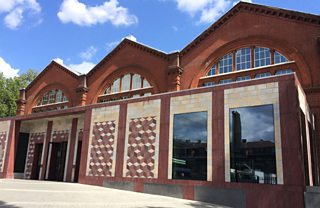
The V&A The Museum of Childhood in Bethnal Green
You may not have heard of Smallfilms, but chances are you have come across The Clangers, Bagpuss, Noggin the Nog or Ivor the Engine. These classic children’s programmes were made by Oliver Postgate and Peter Firmin who, in 1958, came together to create the hugely influential company Smallfilms. The men went on to collaborate for over 30 years and their work is currently being celebrated in an exhibition at the V&A’s Museum of Childhood in East London: .
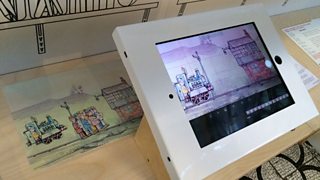
Stop motion exercise on an iPad
The exhibition features original puppets, sets and filming equipment. It also reveals how characters developed, and explains the pair’s ‘stop-frame’ animation techniques, which attendees can even try their hand at – albeit in a much quicker simpler way than the Smallfilmers were used to thanks to an iPad. I went along with my four-year-old who, despite never having encountered any of these characters or worlds before was fascinated by it all. And after nosing around she enjoyed watching some of the episodes in the small screening area.
In the 1950s Oliver Postgate was creating mechanical shop displays and working as an Stage Manager for a TV company; meanwhile Peter Firmin worked in advertising and magazines and was looking for freelance illustration work. The exhibition tells us Firmin didn’t own a TV and “thought television shows were rubbish”.
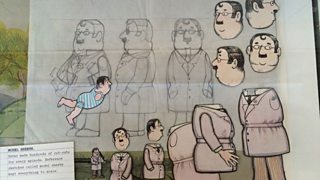
Model sheets
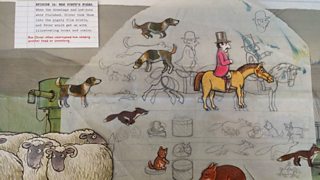
Sketches for Mrs Porty's foxes
The pair met in 1958 and set up Smallfilms. Postgate wrote the stories and Firmin made the pictures and puppets. They worked from a studio on a farm and only had small budgets so used paper cut outs and homemade materials.
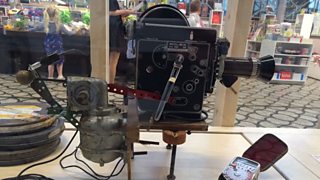
A Bolex Camera
All Smallfilms programmes were made on a ‘Bolex Camera’, a 16mm film camera powered by a “squeezy trigger and a mecano clutch and motor which would drive the camera, very slowly, one frame at a time.” Postgate then used a ‘Moviscop’ to watch the films and count the frames, he did all the editing himself.
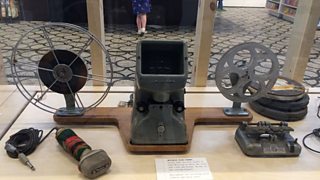
A Moviscop
The exhibition includes amusing fact sheets on each of the television programmes and some fascinating insights into how they were conceived, written and made.
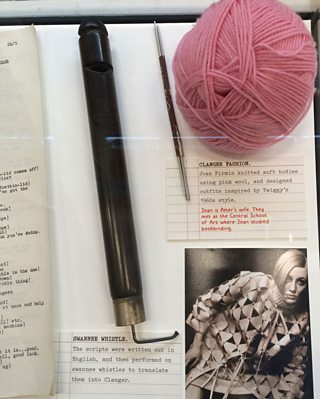
A swanee whistle
For example: a ‘Swanee whistle’ was (and I imagine still is) used to make the Clangers language – however, scripts were written in English and then performed on the whistles to ‘translate’ them into clangers. And the fact sheets explain that Clangers: “captured the excitement of the space race and late 1960s politics. Students in bedsits across the country tuned in.”
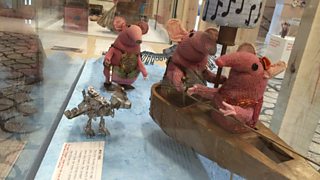
Postgate said: “Filming the Clangers was the most challenging, absorbing and difficult work I have ever undertaken. I found it immensely satisfying, probably because it took all my concentration.”
For the characters in Noggin the Nog, Firmin was inspired by the Lewes Chessmen in the British Museum.
Bagpuss and co are described as “upcycling trailblazers” and you may be surprised to learn that only one series of the show was made, but repeated many times.

Bagpuss' Professor Yaffle
In addition, Professor Yaffle in Bagpuss the “pompous woodpecker who disapproves of silliness” was apparently based on philosopher Bertrand Russell who was a friend of Postgate’s parents. I found that revelation particularly amusing… Russell died in 1970 and Bagpuss didn’t air until 1974 so he never got the chance to watch it or potentially recognise himself – perhaps if he had he’d have exclaimed “fiddlesticks and flapdoodle!” just like the mechanical woodpecker.
